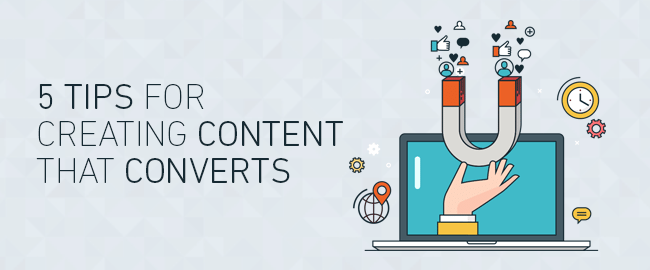
5 Tips For Creating Content That Converts
In this guest blog, Katherine Boyarsky, Acquisition Marketing Manager at HubSpot, discusses her insights on creating killer content.
Content is the cornerstone of any successful marketing and promotion program. It’s the fundamental way to educate your audience on your product or service, and great content helps your audience find you on the web. In inbound marketing, it’s actually the main pillar of our conversion funnel.
HubSpot’s blog generates 2.5 million unique visits per month. Creating noteworthy content can be daunting. Ninety-four percent of B2B marketers say they use content in their marketing but only 42 percent say they are effective at it.
One way to start leveraging content in your marketing strategy is with blogging. From there, work your way to writing more robust offers for your audience. Before you get started, however, you need to consider your audience. Who are you writing for? Here are five easy steps any business can use to build out a content strategy.
-
Determine Your Buyer Personas
What do you know about the last person who purchased your product or service? What is their job role? Where are they? What keeps them up at night? Determining who you’re writing for will help you create a smart strategy that converts. Try these buyer persona templates to get started. You can drill deeper if you:
a. Interview your sales team
b. Use demographic data from your current customer database
c. Leverage form fields on your website to learn more
-
Choose What Types of Content You Should Use
Try using a survey or pulling your own data to determine where your audience is. They might be interested in podcasts, ebooks, or short form blog content. They might crave stories on Medium or on social media, or prefer videos on Facebook. By determining where they already are, you can tailor your content type, length, and tone to the people you’re trying to reach.
-
Gather Existing Content
If you still need an idea for what topic your content will cover, there are a number of resources already available to you, many of which are in your own organization.
a. To give you a kick start on creating content, try using HubSpot’s Blog Topic Generator.
b. Look through your company’s Google docs, Slack messages, internal Wiki, emails, and chats with sales reps, or look at what people are asking on Quora about your industry.
-
Create Your Content
Creating the actual content can be the hardest part, but you can use templates and tools like Beacon to help you. Put together a content calendar to keep yourself on a schedule.
a. Use a guide like The Marketer’s Guide to Writing Well to learn tips and tricks for effective writing.
b. Repurpose existing content. Turn a podcast into an ebook, a blog post into a video, or a webinar into a guide. More bites at the apple leads to more opportunities to convert.
-
Promote! Promote! Promote!
This is the most important step of your content strategy (well, after the content is created, that is). If nobody can find your content, did you really even write it? There are several ways to promote your content, including:
a. On social. Twitter, Facebook and LinkedIn are the biggies, but if you have an infographic, pin it to Pinterest, or post slices of it to Instagram. Engage your audience on the networks they already use.
b. Leverage compelling ads that entice people to click through and download your content.
c. Consider using a content syndication service that puts your content in front of a wider audience.
d. Add calls-to-action (CTAs) on relevant site pages – we recommend HubSpot Marketing Free as a good pop-up tool.
Creating a content strategy is the start of your marketing and sales funnel. Whether you have a one-person team or an entire marketing organization, the principles remain the same. Content is king. Great content brings valued visitors who ultimately turn into qualified leads for your business.
Once you’ve nailed a content strategy, the next step is conversion rate optimization, or CRO. CRO is taking the content and pages you already have and making them work for you by optimizing them for more conversions. You can learn more about this next step here.
About the Author:
Katherine is an acquisition marketing manager at HubSpot who currently works on the HubSpot Marketing Free team. She has a background in demand generation, email marketing, PR, and journalism, and has helped grow HubSpot’s prospect generation funnel and expand its reach to brand new channels.

Is any training forn you guys on wordpress and content.??
Hey Henry – HubSpot Academy has a free Content Marketing Certification course here: http://certification.hubspot.com/content-marketing-certification-course
Great post Katherine, You really mentioned some mind blowing tips on getting the content read,shared and talked.
Great post! Or Blog? I’m not sure which but I enjoyed it nevertheless. I once attempted to write a blog many years ago, I believe it was a word press, I tried to be witty and insightful and was gung-ho… even pushing that submit button. After a few weeks of no shows to my page I lost interest, meh. Anyway I do love reading post or blogs? Still not totally sure but, hey either way I’m reading your writing and were both happier for it. Keep it up!
I can’t judge your post you are just outstanding really i am very happy